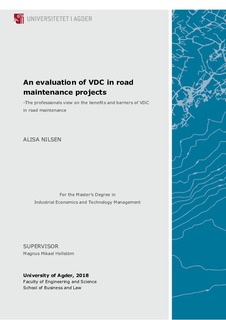| dc.contributor.author | Nilsen, Alisa | |
| dc.date.accessioned | 2018-10-08T11:29:17Z | |
| dc.date.available | 2018-10-08T11:29:17Z | |
| dc.date.issued | 2018 | |
| dc.identifier.uri | http://hdl.handle.net/11250/2566859 | |
| dc.description | Master's thesis Industrial Economics and Technology Management IND590 - University of Agder 2018 | nb_NO |
| dc.description.abstract | Purpose: Give an overview of VDC in relation to road maintenance projects and make it easier for companies to decide if VDC is worth investing in.
Goal: 1) To find out if there are any differences in the definition and understanding of VDC in the Norwegian market, compared to the definition provided by the CIFE (Center for Integrated Facility Engineering at Stanford University).
2) To identify frequent problems in road maintenance that VDC could solve.
3) To identify the obstacles standing in the way of the use of VDC in road maintenance and to figure out why it has not been adopted in road maintenance projects.
Methodology: The thesis takes a pragmatic, critical realist approach to the problem. It builds on qualitative studies through interviews where personal perceptions are interpreted from the standpoint of existing structures of the construction industry.
Findings: 1) CIFE’s definition of VDC is prominent, but it seems like Norwegian companies have also adapted the definition to suit Norwegian workplaces better. There is a greater focus on collaboration, communication and involved planning. There is a similar understanding of what VDC entails throughout the professionals in the industry, but there is an obvious knowledge gap when it comes to VDC between the ones who perform the jobs and the upper management.
2) The most frequent problems in road maintenance projects lie in communication, knowledge, digital programs and metrics. In the three cases of communication, digital programs and metrics there is reason to believe that the use of VDC could impact road maintenance projects in a positive way. The lack of sufficient knowledge is not something VDC could solve and is rather an obstacle when it comes to the use of VDC.
III
3) The main obstacles in the way of implementing VDC in road maintenance are the lack of knowledge about VDC and the lack of metrics to back up how VDC can lead to improvements in road maintenance projects (or any other type of project).
Conclusion: VDC can improve communication and collaboration through ICE and iRoom in road maintenance, though there are some costs and efforts associated with implementing and practicing VDC. The question is: Do the benefits outweigh the costs and efforts?
To be certain that VDC is worth investing in, there is a need for more quantitative research, but based on qualitative data gathered throughout the thesis, it could be worth looking more into the full use of VDC in road maintenance. | nb_NO |
| dc.language.iso | eng | nb_NO |
| dc.publisher | Universitetet i Agder ; University of Agder | nb_NO |
| dc.rights | Attribution-NonCommercial-NoDerivatives 4.0 Internasjonal | * |
| dc.rights.uri | http://creativecommons.org/licenses/by-nc-nd/4.0/deed.no | * |
| dc.subject | IND590 | nb_NO |
| dc.title | An evaluation of VDC in road maintenance projects -The professionals view on the benefits and barriers of VDC in road maintenance | nb_NO |
| dc.type | Master thesis | nb_NO |
| dc.subject.nsi | VDP::Teknologi: 500::Bygningsfag: 530::Bygg-, anleggs- og transportteknologi: 532 | nb_NO |
| dc.subject.nsi | VDP::Teknologi: 500::Informasjons- og kommunikasjonsteknologi: 550 | nb_NO |
| dc.source.pagenumber | 108 p. | nb_NO |

